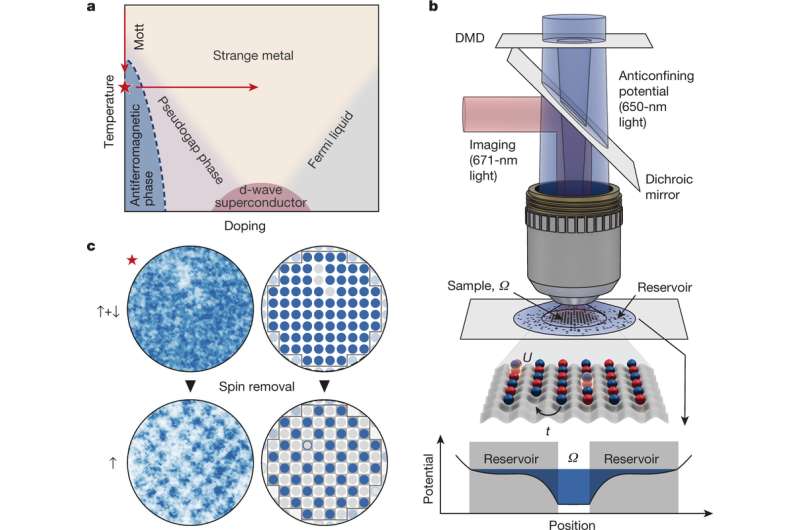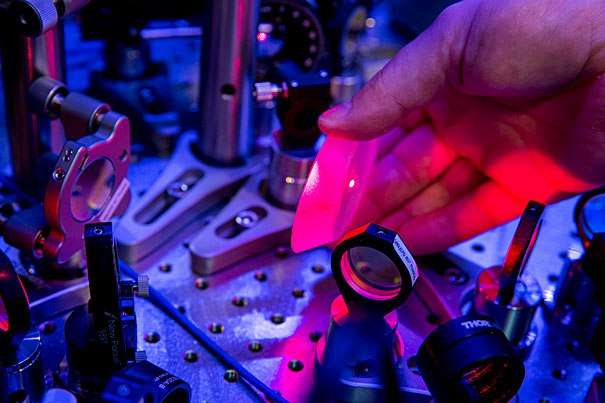May 25, 2017 report
Harvard team creates a cold-atom Fermi–Hubbard antiferromagnet

(Phys.org)—A team at Harvard University has found a way to create a cold-atom Fermi–Hubbard antiferromagnet, which offers new insight into how electrons behave in solids. In their paper published in the journal Nature, the group describes their experiments, a new tool they developed, and what they believe they have demonstrated using cold atoms in optical lattices in exploring the Fermi–Hubbard model. Thierry Giamarchi with the University of Geneva offers a News & Views piece on the work done by the team and offers background regarding the Fermi–Hubbard model, including an explanation of why simulating the model is so important.
As scientists continue to look for superconductivity at room temperatures, they advance the understanding of electron behavior in solids—specifically the ways quantum-mechanical interactions work regarding electronic properties. Calculating such interactions has proved to be beyond current capabilities, so scientists have developed models that can be calculated instead. One of these, the Fermi–Hubbard model, is based on Fermi-Dirac particles jumping between points on a lattice. Unfortunately, despite its simplicity, calculations for the model can only be made for one-dimensional lattice points.
To use the model to develop superconductors, 2-D calculations are required. Because of this limitation, some scientists have attempted to create a physical entity to simulate a Fermi–Hubbard model. In this new effort, the researchers have created just such a physical entity, and in doing so, have come closer to achieving the Fermi–Hubbard model than other attempts. They have done so by overcoming two major problems that stymied other teams: achieving low enough temperatures, and solving density representation problems.

The researchers created a lattice using lasers and then trapped lithium-6 atoms in its wells. They then added a new feature to cool the system by surrounding the lattice with other atoms that served as a coolant. To overcome the density issues, they developed what they describe as a "fermionic microscope" to track points on the lattice. After filling the lattice with atoms, the group reports that the entire scheme behaved like an antiferromagnetic insulator. They suggest their creation could be used to study a wide variety of physics problems, and possibly to help in the search for a high-temperature superconductor.
More information: Anton Mazurenko et al. A cold-atom Fermi–Hubbard antiferromagnet, Nature (2017). DOI: 10.1038/nature22362
Abstract
Exotic phenomena in systems with strongly correlated electrons emerge from the interplay between spin and motional degrees of freedom. For example, doping an antiferromagnet is expected to give rise to pseudogap states and high-temperature superconductors. Quantum simulation using ultracold fermions in optical lattices could help to answer open questions about the doped Hubbard Hamiltonian, and has recently been advanced by quantum gas microscopy. Here we report the realization of an antiferromagnet in a repulsively interacting Fermi gas on a two-dimensional square lattice of about 80 sites at a temperature of 0.25 times the tunnelling energy. The antiferromagnetic long-range order manifests through the divergence of the correlation length, which reaches the size of the system, the development of a peak in the spin structure factor and a staggered magnetization that is close to the ground-state value. We hole-dope the system away from half-filling, towards a regime in which complex many-body states are expected, and find that strong magnetic correlations persist at the antiferromagnetic ordering vector up to dopings of about 15 per cent. In this regime, numerical simulations are challenging and so experiments provide a valuable benchmark. Our results demonstrate that microscopy of cold atoms in optical lattices can help us to understand the low-temperature Fermi–Hubbard model.
Journal information: Nature
© 2017 Phys.org




















